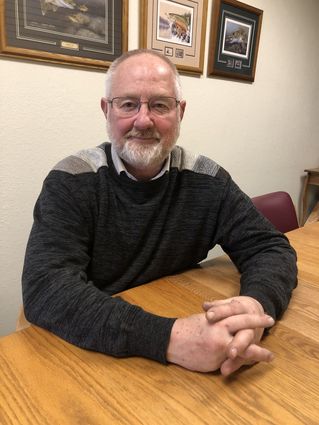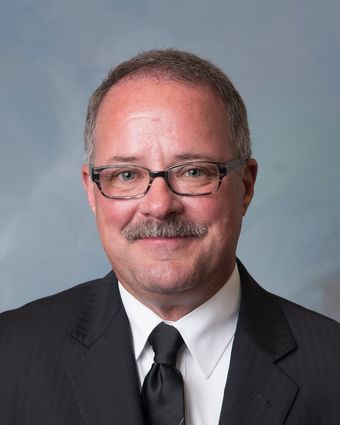Funeral directors, families deal with limitations
April 10, 2020

Jana Peterson
Rob Nelson of Nelson Funeral Care and Cremation Service in Cloquet says many people are choosing to wait for now on funeral services.
Funerals - as normally practiced - have become another victim of the coronavirus pandemic response.
With gatherings of more than 10 people banned, people are either postponing a, making them for immediate family only or getting creative, like the drive-through funeral held in Moose Lake last month or livestreaming a smaller funeral service so others can watch from a distance.
In most cases, said Rob Nelson, people are choosing to wait, at least for now.
"Even before now, you would have a lot of families have a death, have the body cremated and wait a couple months or even six months because they want to have the service when there's a family get together, or something like that," said Nelson, of Nelson Funeral Care and Cremation Service in Cloquet.
The state guidelines allow individuals to leave home to attend funerals, provided there are no more than 10 people (including clergy) and that the space allows for social distancing. Bob Atkins, of Atkins-Northland Funeral Home and Cremation Service, said holding a graveside service outside for 10 people or fewer is recommended for now.
Funeral directors are trying to satisfy people's needs to mourn while abiding by the state and federal recommendations.
Atkins said he has recorded at least two funerals since the COVID-19 restrictions began and posted those recordings to the funeral home website so more people could watch the service but remain safely at home. He doesn't have a way of counting how many people watched a certain video, but he said website traffic jumped from an average of 600 views a day to 2,100 one day and 1,600 the next.
Atkins also said he has the space to hold basically what would be a drive-up visitation, where he could place the deceased next to the window inside, and allow people to drive up, one vehicle at a time, and get out and view the person and sign a guestbook under a patio roof outside.
In one case where a person had pre-paid for services including a luncheon, he sent each branch of the family home with food and they watched the funeral together from home.
"Everything is better around food," he said. "We are doing our best for families, but we also want to be smart and keep everyone safe."
Grieving the loss of a loved one doesn't have to wait for a formal ceremony, but there are many who need that chance to come and say goodbye, Nelson said.
"People need to grieve now. Everybody grieves differently," Nelson said. "Some people grieve without seeing the body, some need to see the body."
Regardless of a family's choice, they can still come to the funeral home and say goodbye now, even if they choose to cremate and hold the actual service later, Nelson said.
It's the physical connection that's missing in the grieving process now, Atkins pointed out.
"When you have a gathering, you're all mourning together," he said. "People are still dropping off meals, sending flowers and cards, condolences can still happen. It's the physical togetherness that we're missing out on."
Grief therapist Kelly Grosklags shared some suggestions with funeral directors for helping families find closure during this unique time, including the following:
• Light a memory candle as a family, either in person or via Zoom, Skype or Facetime. As each person lights a candle, say what they will miss about the deceased and what they learned from them.
• Schedule dinner with immediate family if it feels safe to do so. Stay in touch via email, streaming or good old-fashioned phone calls and letters.
• Frame a photo of a loved one and place it somewhere special. Light a candle. Talk to your person out loud. "This is perfectly acceptable and can be very cathartic for many," ?? wrote.
• Start a journal to write out your feelings.
• Announce the death on social media.
• Hold a prayer service over the phone or through other means.
Grosklags said there is a bright side to delaying services for a couple months, because "this is often a time when the bereaved feel people have moved on and forgotten the death and their loved one."
"This is an opportunity to come together as a community when typically the numbness is subsiding, and you may be able to be more present for the actual service," he said. "This time also allows for us to be more intentional."
Nelson said he expects a rush of funerals once the order against larger gatherings is lifted and funerals can go back to being a larger gathering of mourners.
*************
Extreme caution is regular course for morticiansWorkers performing mortuary services, including funeral homes, crematoriums, and cemetery workers, are essential workers during COVID-19 response, under the terms of the order by Gov. Tim Walz as well as recommendations from the U.S. Department of Homeland Security.
They're open for business, and preparing for worse things to come in northern Minnesota.
When asked if he's worried about dealing with the bodies of people who have died from COVID-19, the disease caused by the coronavirus, Cloquet funeral director Rob Nelson said "no."
That's because funeral directors are trained to use extreme precautions. "We treat everybody as if they have a contagious disease to protect ourselves," he said. "Because we don't know. We're supposed to be notified, but that doesn't always happen. So in our embalming room, we have personal protective equipment just like they've been talking about for doctors and nurses, everything from hats to booties, gowns, goggles to respirator (masks)."
That is the normal routine in the embalming, or prep room. Fellow funeral director Bob Atkins of Atkins-Northland, said in the time of coronavirus, he and other funeral directors are changing how they dress to remove a person's body from a home or the hospital. The suit and tie will be covered with a protective gown, and he'll be wearing gloves and a mask as well.
While neither Cloquet funeral home owner had dealt with a COVID-19 death as of April 8, they both expect it to happen.
"It's not a question of if, but when it happens," Atkins said.
Atkins said he's been contacted by state and regional officials asking about resources. He has two crematoriums in Scanlon, one for pets and one for people. Atkins said he runs the cremation service for people through the funeral home - not as a service for hire for other funeral homes - although he suspects if numbers of deaths climb, his crematoriums will be used for others as well.
It's business as usual at the pet cremation service right now, he said, although they're limiting face-to-face contact with pet owners.
In New York City, where the infection rate is the highest in the nation, officials are using refrigeration trailers along with other facilities with large-scale refrigeration available because hospitals and funeral homes don't have that kind of space for the dead.
- Jana Peterson / Pine Knot News



